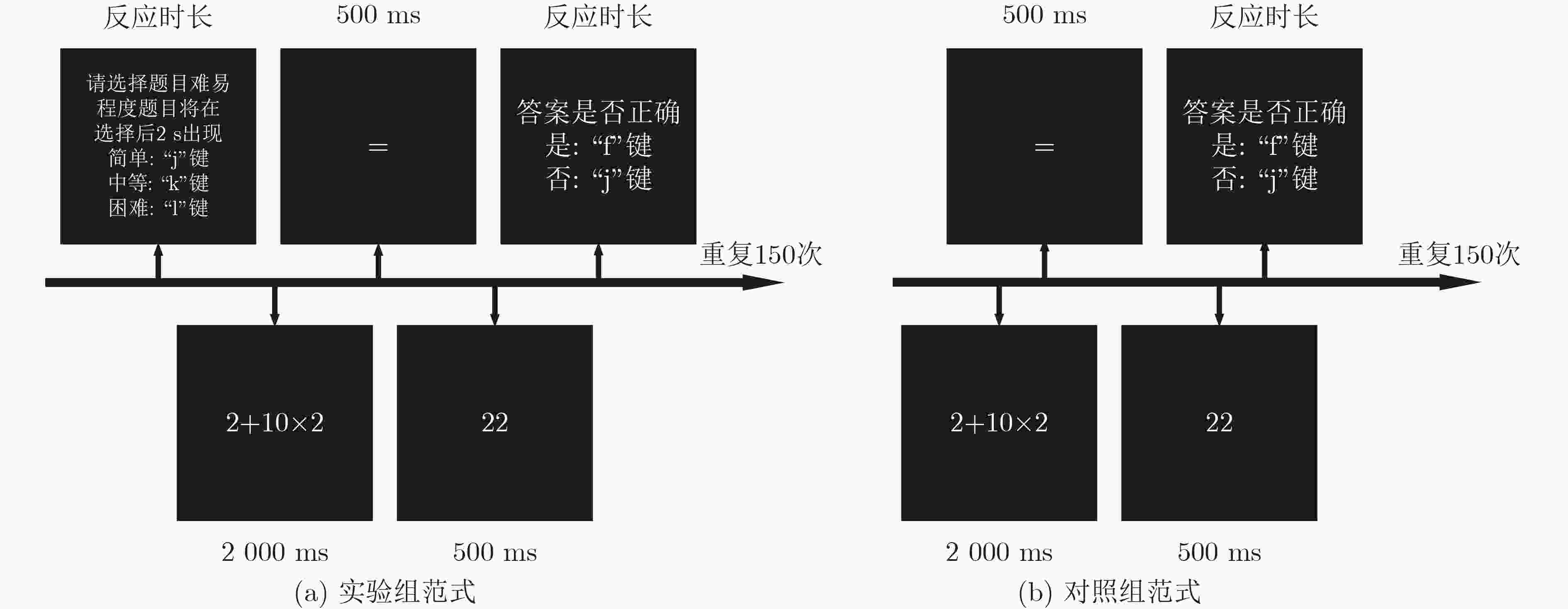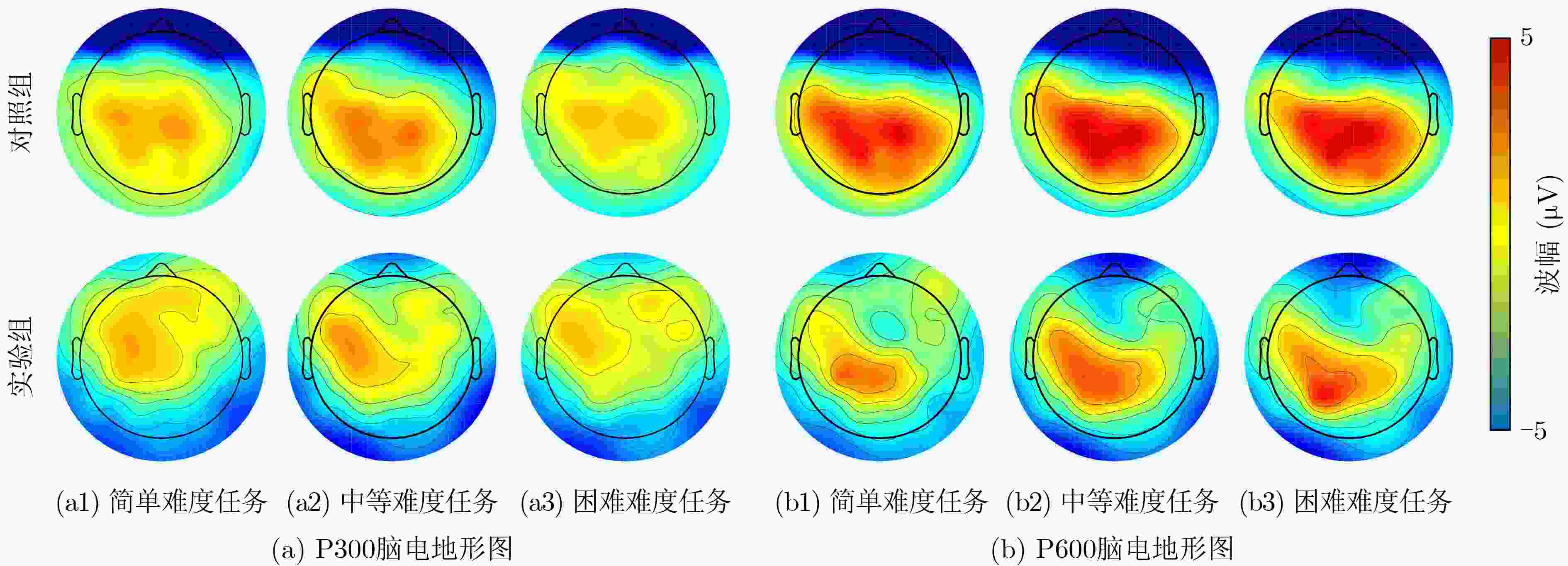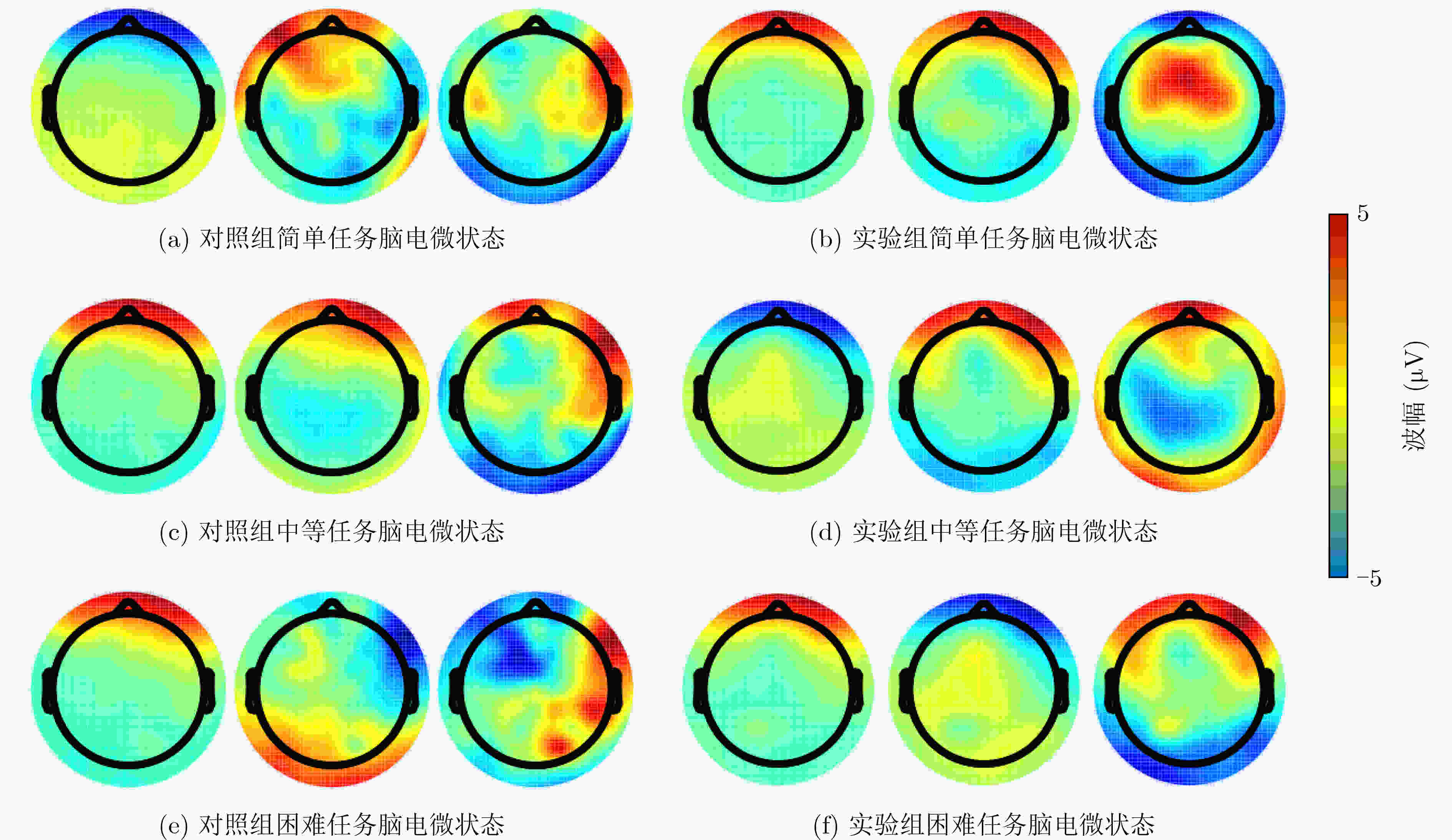Impact of Self-regulation on Mental Workload under Different Difficulty Tasks
-
摘要: 持续的高水平心理负荷会导致不良的自我调节行为,但面向不同难度任务时自我调节行为对心理负荷的影响尚不明确。该文提出一种面向不同难度任务,基于自我调节行为的算术范式。被试者在每轮开始前可以根据自己的决策自行选择题目难度任务。范式可以观察在自我调节下,不同难度任务对被试者心理负荷的影响。该文使用事件相关电位(ERP)、功率谱密度(PSD)及脑电微状态进行分析。结果表明,在不同任务难度下,自我调节行为均引发了额外的心理负荷。自我调节行为主要与额叶区域有关,表现出P300振幅及theta,alpha频带功率增大,P600振幅减小。在中等难度任务下,自我调节引发的额外负荷较小,且促使被试者表现出更好的绩效水平。该文范式能够有效地识别出适合被试者的任务难度。在实际任务设计中,应考虑适合被试者的任务难度,减少不良自我调节行为的发生,提升被试者的绩效水平。Abstract: It has been shown that sustained high mental workload will lead to poor self-regulation behaviors, but the effect of self-regulation behavior on mental workload is not clear when facing different difficulty tasks. An arithmetic paradigm based on self-regulating behavior for tasks of varying difficulty is proposed. The subjects can choose the questions according to their own decisions before the start of each round. The paradigm can observe the effect of different difficulty tasks on the subjects’ mental workload under self-regulation. The analysis can be performed using Event-Related Potential (ERP), Power Spectral Density (PSD), and microstates. The results show that under different tasks, self-regulation behaviors cause more mental workload. The self-regulation behavior is mainly related to the frontal, which shows stronger P300 amplitudes and theta and alpha band power, and smaller P600 amplitudes. On the moderately difficult task, the mental workload induced by self-regulation is smaller and prompts the subjects to exhibit better performance levels. This paradigm can effectively identify the task difficulty suitable for the subjects. In the actual task design, the difficulty of the task suitable for the subjects should be considered, so as to reduce the occurrence of poor self-regulation behaviors and improve the performance level of the subjects.
-
表 1 行为学数据分析结果
正确数 简单难度任务答题用时 中等难度任务答题用时 困难难度任务答题用时 均值(n) 方差(n) P值 均值
(s)方差
(s)P值 均值(s) 方差(s) P值 均值(s) 方差(s) P值 实验组 41.17 3.22 0.036 1.49 2.38 <0.001 2.59 3.58 <0.001 4.63 6.68 <0.001 对照组 44.22 4.97 2.74 3.85 1.64 2.19 2.79 3.85 表 2 完成简单难度任务时P300分析结果
额叶 中央头顶区-顶叶 顶叶 均值(µV) 方差(µV) P值 均值(µV) 方差(µV) P值 均值(µV) 方差(µV) P值 实验组 4.17 2.78 0.002 2.81 1.86 0.011 2.36 2.12 <0.001 对照组 2.98 2.18 3.66 2.5 3.9 2.97 表 3 完成简单难度任务时P600分析结果
额叶 中央头顶区 中央头顶区-顶叶 顶叶 均值(µV) 方差(µV) P值 均值(µV) 方差(µV) P值 均值(µV) 方差(µV) P值 均值(µV) 方差(µV) P值 实验组 0.88 1.91 0.03 2.12 2.54 0.001 3.19 2.5 0.007 2.53 2.79 0.001 对照组 –0.21 2.81 3.45 2.51 4.4 3.37 4.16 3.4 表 4 完成中等难度任务时P300分析结果
额叶 中央头顶区-顶叶 顶叶 均值(µV) 方差(µV) P值 均值(µV) 方差(µV) P值 均值(µV) 方差(µV) P值 实验组 4.33 1.75 0.001 2.65 2.03 0.035 2.67 2.51 0.037 对照组 2.91 3.49 3.42 2.68 3.54 2.91 表 5 完成中等难度任务时P600分析结果
额叶 中央头顶区 中央头顶区-顶叶 顶叶 均值(µV) 方差(µV) P值 均值(µV) 方差(µV) P值 均值(µV) 方差(µV) P值 均值(µV) 方差(µV) P值 实验组 0.63 2.73 0.005 2.78 2.51 0.013 3.48 2.9 0.003 3.27 3.28 0.004 对照组 –0.74 3.54 3.76 2.57 4.98 3.48 4.84 3.6 -
[1] INZLICHT M, WERNER K M, BRISKIN J L, et al. Integrating models of self-regulation[J]. Annual Review of Psychology, 2021, 72: 319–345. doi: 10.1146/annurev-psych-061020-105721 [2] 文书锋, 汤冬玲, 俞国良. 情绪调节自我效能感的应用研究[J]. 心理科学进展, 2009, 32(3): 666–668. doi: 10.16719/j.cnki.1671-6981.2009.03.025WEN Shufeng, TANG Dongling, and YU Guoliang. The characteristics of regulatory emotional self-efficacy in Chinese graduate students[J]. Psychological Science, 2009, 32(3): 666–668. doi: 10.16719/j.cnki.1671-6981.2009.03.025 [3] NIGG J T. Annual research review: On the relations among self-regulation, self-control, executive functioning, effortful control, cognitive control, impulsivity, risk-taking, and inhibition for developmental psychopathology[J]. Journal of Child Psychology and Psychiatry, 2017, 58(4): 361–383. doi: 10.1111/jcpp.12675 [4] HEATHERTON T F. Neuroscience of self and self-regulation[J]. Annual Review of Psychology, 2011, 62: 363–390. doi: 10.1146/annurev.psych.121208.131616 [5] PAUL K, POURTOIS G, VAN STEENBERGEN H, et al. Finding a balance: Modulatory effects of positive affect on attentional and cognitive control[J]. Current Opinion in Behavioral Sciences, 2021, 39: 136–141. doi: 10.1016/j.cobeha.2021.03.002 [6] MACDONALD III A W, COHEN J D, STENGER V A, et al. Dissociating the role of the dorsolateral prefrontal and anterior cingulate cortex in cognitive control[J]. Science, 2000, 288(5472): 1835–1838. doi: 10.1126/science.288.5472.1835 [7] 王益文, 林崇德. 额叶参与执行控制的ERP负荷效应[J]. 心理学报, 2005, 37(6): 723–728.WANG Yiwen and LIN Chongde. Frontal involvement to executive control: Load effects reflected by ERPs[J]. Acta Psychologica Sinica, 2005, 37(6): 723–728. [8] GALY E and MÉLAN C. Effects of cognitive appraisal and mental workload factors on performance in an arithmetic task[J]. Applied Psychophysiology and Biofeedback, 2015, 40(4): 313–325. doi: 10.1007/s10484-015-9302-0 [9] DEHAIS F, LAFONT A, ROY R, et al. A neuroergonomics approach to mental workload, engagement and human performance[J]. Frontiers in Neuroscience, 2020, 14: 268. doi: 10.3389/fnins.2020.00268 [10] BAKKER A B and DE VRIES J D. Job Demands-Resources theory and self-regulation: New explanations and remedies for job burnout[J]. Anxiety, Stress & Coping, 2021, 34(1): 1–21. doi: 10.1080/10615806.2020.1797695 [11] 范伟, 杨博, 刘娟, 等. 自我欺骗: 为了调节个体心理状态[J]. 心理科学进展, 2017, 25(8): 1349–1359. doi: 10.3724/sp.J.1042.2017.01349FAN Wei, YANG Bo, LIU Juan, et al. Self-deception: For adjusting individual psychological states[J]. Advances in Psychological Science, 2017, 25(8): 1349–1359. doi: 10.3724/sp.J.1042.2017.01349 [12] KÄTHNER I, WRIESSNEGGER S C, MÜLLER-PUTZ G R, et al. Effects of mental workload and fatigue on the P300, alpha and theta band power during operation of an ERP (P300) brain-computer interface[J]. Biological Psychology, 2014, 102: 118–129. doi: 10.1016/j.biopsycho.2014.07.014 [13] DEHAIS F, DUPRÈS A, BLUM S, et al. Monitoring Pilot's mental workload using ERPs and spectral power with a six-dry-electrode EEG system in real flight conditions[J]. Sensors, 2019, 19(6): 1324. doi: 10.3390/s19061324 [14] DEMURU M, LA CAVA S M, PANI S M, et al. A comparison between power spectral density and network metrics: An EEG study[J]. Biomedical Signal Processing and Control, 2020, 57: 101760. doi: 10.1016/j.bspc.2019.101760 [15] MICHEL C M and KOENIG T. EEG microstates as a tool for studying the temporal dynamics of whole-brain neuronal networks: A review[J]. NeuroImage, 2018, 180: 577–593. doi: 10.1016/j.neuroimage.2017.11.062 [16] KHANNA A, PASCUAL-LEONE A, and FARZAN F. Reliability of resting-state microstate features in electroencephalography[J]. PLoS One, 2014, 9(12): e114163. doi: 10.1371/journal.pone.0114163 [17] SUBASI A and GURSOY M I. EEG signal classification using PCA, ICA, LDA and support vector machines[J]. Expert Systems with Applications, 2010, 37(12): 8659–8666. doi: 10.1016/j.eswa.2010.06.065 [18] 陈强, 陈勋, 余凤琼. 基于独立向量分析的脑电信号中肌电伪迹的去除方法[J]. 电子与信息学报, 2016, 38(11): 2840–2847. doi: 10.11999/JEIT160209CHEN Qiang, CHEN Xun, and YU Fengqiong. Removal of muscle artifact from EEG data based on independent vector analysis[J]. Journal of Electronics &Information Technology, 2016, 38(11): 2840–2847. doi: 10.11999/JEIT160209 [19] YANG Qiwei, TANG Ping, GU Ruolei, et al. Implicit emotion regulation affects outcome evaluation[J]. Social Cognitive and Affective Neuroscience, 2015, 10(6): 824–831. doi: 10.1093/scan/nsu124 [20] BLISSETT S, SIBBALD M, KOK E, et al. Optimizing self-regulation of performance: Is mental effort a cue[J]. Advances in Health Sciences Education, 2018, 23(5): 891–898. doi: 10.1007/s10459-018-9838-x [21] RON-ANGEVIN R, GARCIA L, FERNÁNDEZ-RODRÍGUEZ Á, et al. Impact of speller size on a visual P300 brain-computer interface (BCI) system under two conditions of constraint for eye movement[J]. Computational Intelligence and Neuroscience, 2019, 2019: 7876248. doi: 10.1155/2019/7876248 [22] ZHANG Zhonglu, LUO Yu, WANG Chaolun, et al. Identification and transformation difficulty in problem solving: Electrophysiological evidence from chunk decomposition[J]. Biological Psychology, 2019, 143: 10–21. doi: 10.1016/j.biopsycho.2019.02.004 [23] MUN S, WHANG M, PARK S, et al. Effects of mental workload on involuntary attention: A somatosensory ERP study[J]. Neuropsychologia, 2017, 106: 7–20. doi: 10.1016/j.neuropsychologia.2017.08.021 [24] PERGHER V, WITTEVRONGEL B, TOURNOY J, et al. Mental workload of young and older adults gauged with ERPs and spectral power during N-Back task performance[J]. Biological Psychology, 2019, 146: 107726. doi: 10.1016/j.biopsycho.2019.107726 [25] HUANG Yihao, HE Feng, XU Minpeng, et al. Operate P300 speller when performing other task[J]. Journal of Neural Engineering, 2020, 17(5): 056022. doi: 10.1088/1741-2552/abb4a6 [26] PUMA S, MATTON N, PAUBEL P V, et al. Using theta and alpha band power to assess cognitive workload in multitasking environments[J]. International Journal of Psychophysiology, 2018, 123: 111–120. doi: 10.1016/j.ijpsycho.2017.10.004 [27] RAAIJMAKERS S F, BAARS M, SCHAAP L, et al. Effects of performance feedback valence on perceptions of invested mental effort[J]. Learning and Instruction, 2017, 51: 36–46. doi: 10.1016/j.learninstruc.2016.12.002 -






 下载:
下载:








 下载:
下载:
